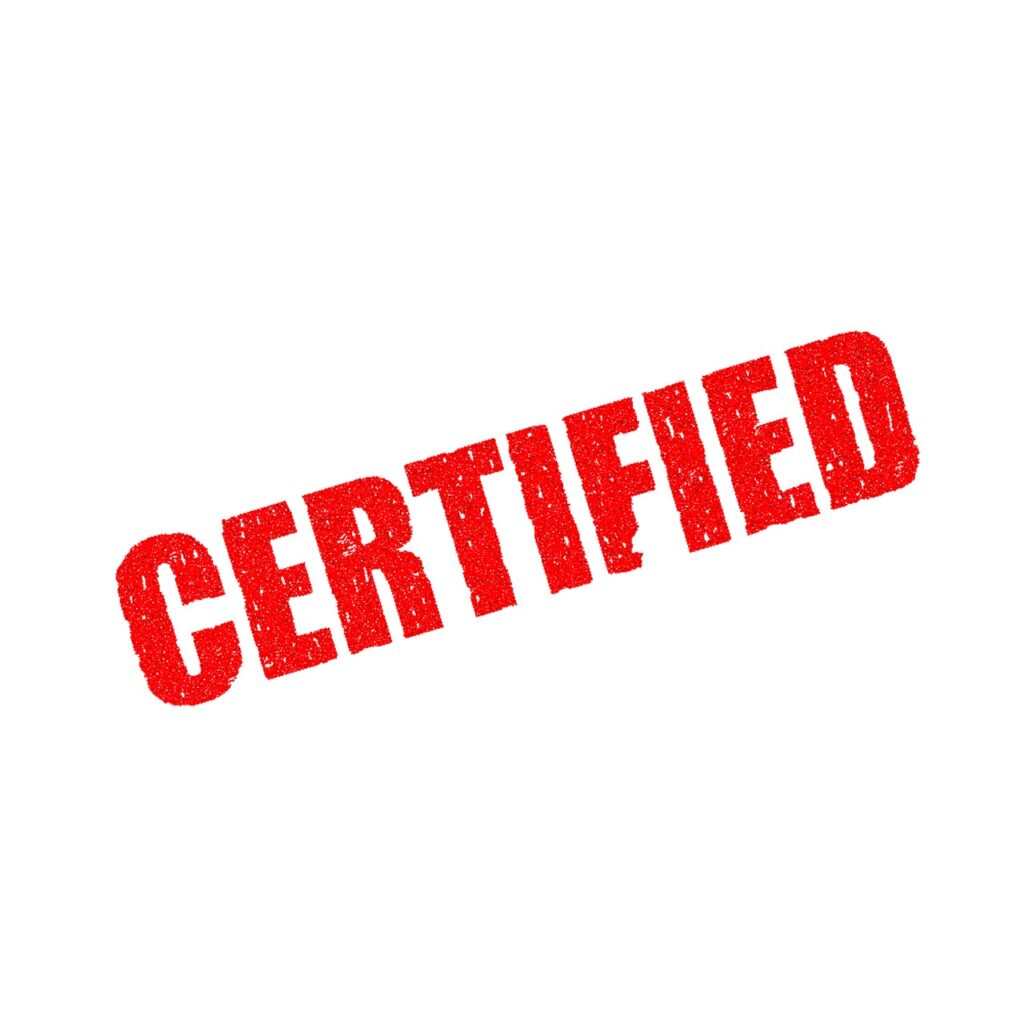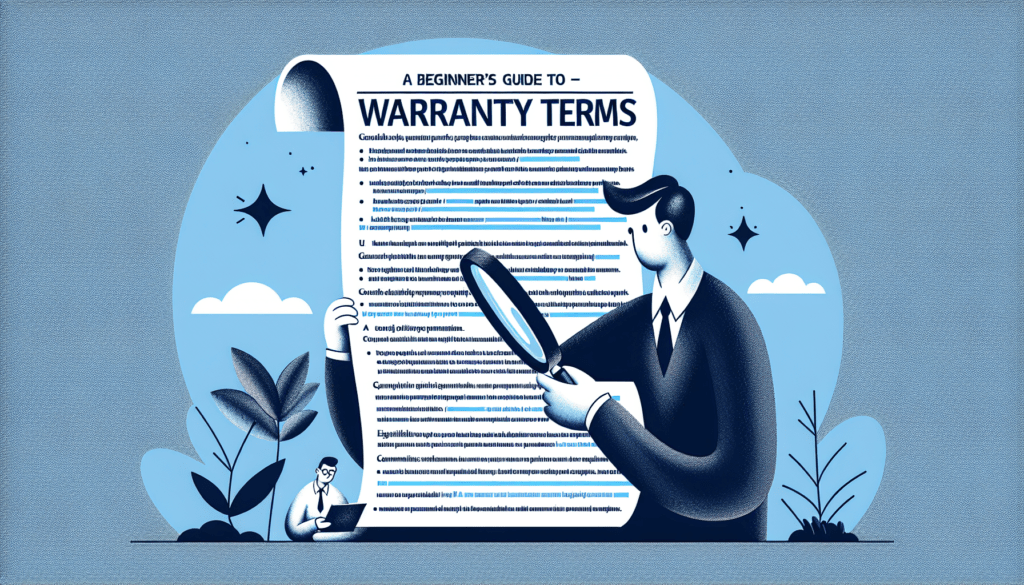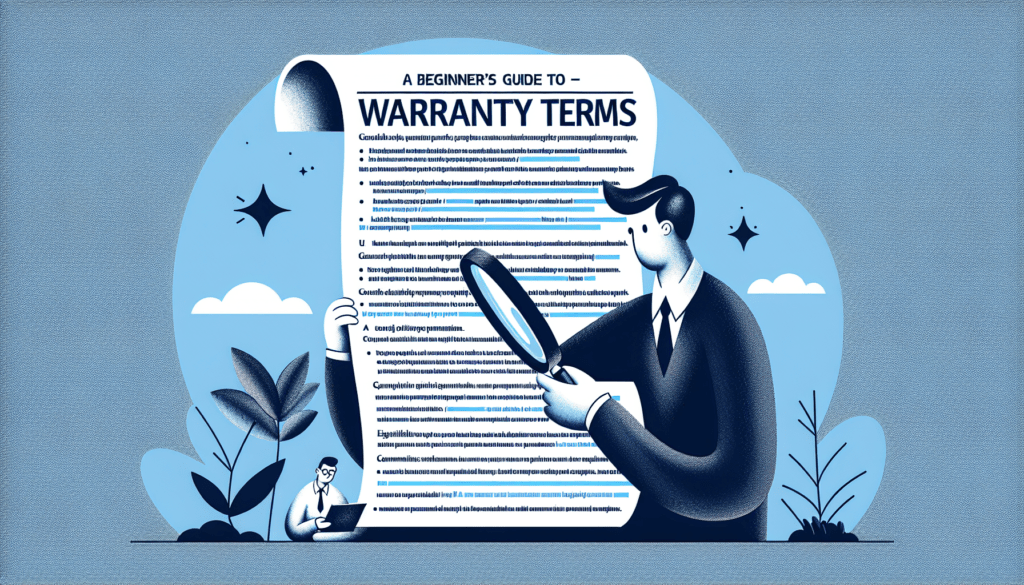So, you’ve just purchased a brand new gadget or appliance, and along with it comes a warranty. You’re excited about your new purchase, but now you’re faced with the daunting task of reading and understanding all those warranty terms. Don’t worry, this beginner’s guide is here to help. In this article, we’ll break down the key aspects you need to know about warranty terms, making it easier for you to navigate through the fine print and ensure you get the most out of your purchase.

Understanding the Basics of Warranty Terms
What is a warranty?
A warranty is a contract between the buyer and the seller that provides assurance and protection for a product or service. It guarantees that the product or service will meet certain standards or perform as expected for a specified period. Warranties offer peace of mind to consumers and help build trust in the brand or manufacturer.
Why are warranty terms important?
Warranty terms play a crucial role in understanding the rights and obligations of both the buyer and the seller. They outline the scope of coverage, duration, limitations, and exceptions. By understanding the warranty terms, you can make informed decisions about purchases, know what repairs or replacements are covered, and be aware of any costs or responsibilities you may have as the warranty holder.
Different types of warranties
There are various types of warranties, each with its own coverage and duration. The most common types include:
-
Implied warranties: These warranties are automatically applicable by law and do not require explicit documentation. Implied warranties, such as the warranty of merchantability or fitness for a particular purpose, assure that the product will function as expected.
-
Express warranties: These warranties are explicitly provided by the seller or manufacturer and are usually in writing or part of the product packaging or documentation. Express warranties specify the duration, coverage, and other terms and conditions.
-
Limited warranties: Limited warranties define specific parameters of coverage, such as only covering certain components or excluding damages caused by misuse or accidents. They have defined limitations and exclusions that you need to be aware of.
-
Full warranties: Full warranties provide comprehensive coverage for the entire product and are often seen as more consumer-friendly. They cover all parts and labor needed to repair the product within the specified period.
Analyzing the Coverage
What does the warranty cover?
To understand the coverage provided by a warranty, you need to carefully review the terms. The warranty may cover various aspects, such as defects in materials and workmanship, repair or replacement costs, and sometimes even accidental damage. Make sure the coverage aligns with your expectations and needs, especially if you are purchasing a high-value product.
What is excluded from the warranty coverage?
While warranties offer protection, they also have exclusions. Common exclusions include damages caused by misuse, neglect, accidents, or unauthorized repairs. Some warranties may not cover consumable parts or normal wear and tear. It is essential to be aware of these exclusions to prevent any surprises when making a claim.
Understanding the duration of coverage
Warranty coverage has a set period, which can vary depending on the product and manufacturer. Some warranties offer coverage for a specific number of years, while others have a lifetime warranty. It is vital to understand the duration of coverage to determine how long you can file a claim if needed. Remember to check if the warranty has any conditions or requirements for maintaining its validity over time.
Interpreting the Terms and Conditions
Language and terminology used in warranty terms
Warranty terms often contain technical language and specific terminology. While it may seem intimidating, taking the time to understand the meaning of these terms is essential. If you are unsure about any wording, consult the glossary or reach out to the manufacturer’s customer support for clarification. Understanding the language used will help you fully grasp the obligations and rights outlined in the warranty.
How to interpret specific clauses
Some warranty terms may contain specific clauses that require careful interpretation. For example, a “reasonable wear and tear” clause may limit coverage for damages resulting from everyday usage. It is crucial to comprehend such clauses to avoid misunderstandings regarding what is covered and what is not. If a clause seems ambiguous, it is advisable to seek legal advice or contact the manufacturer for clarification.
Key disclosure requirements
Warranty terms should include clear disclosure of certain information. This typically includes the identity of the warrantor, a description of the product or service covered, details about how to obtain warranty service, and any limitations or exclusions. Ensure that these requirements are met to ensure your rights are protected and to have a clear understanding of what is expected from both you and the warrantor.
Identifying Limitations and Exceptions
Limitations on liability
Warranty terms often outline limitations on the liability of the warrantor. This means that the warrantor may not be responsible for certain types of damages, indirect or consequential damages, or damages exceeding the cost of the product. Understanding these limitations helps manage expectations and allows you to assess potential risks associated with the product or service.
Exceptions to coverage
In addition to limitations, warranty terms may also include exceptions to coverage. These exceptions specify circumstances or conditions under which the warranty will not apply. For example, a warranty for a smartphone may exclude damages caused by exposure to water. By identifying these exceptions, you can take necessary precautions to avoid potential voiding of the warranty.
Responsibilities of the warranty holder
Warranty terms often outline certain responsibilities and obligations for the warranty holder. These may include proper maintenance, adhering to usage guidelines, and following recommended procedures for troubleshooting or reporting issues. Understanding your responsibilities as the warranty holder ensures that you comply with the requirements and maximize the benefits provided by the warranty.

Reading the Fine Print
Identifying deceptive or misleading statements
When reading warranty terms, it is essential to be on the lookout for any deceptive or misleading statements. Manufacturers may use various tactics to limit their liability or misrepresent the coverage. Pay close attention to any statements that seem too vague or could be interpreted in multiple ways. If you come across any questionable statements, consult unbiased sources or seek legal advice to ensure you are not being misled.
Uncovering hidden fees or charges
Hidden fees or charges can be an unpleasant surprise when making a warranty claim. Review the terms thoroughly to identify any potential expenses you may be responsible for. For example, some warranties require you to cover shipping costs when sending the product for repairs. By uncovering these hidden fees in advance, you can budget accordingly and avoid unexpected financial burdens.
Understanding the cancellation policy
Warranty terms may include information about the cancellation policy. This outlines the conditions under which the warranty can be canceled and any associated costs or penalties. It is crucial to understand your rights and obligations if you decide to cancel the warranty. Make sure to familiarize yourself with the cancellation policy before making a purchase to avoid any unwelcome surprises later on.
Determining Activation and Registration Requirements
Steps to activate the warranty
Some warranties require activation to become effective. This typically involves completing a registration process, either online or through mail. Ensure that you understand and follow the steps for activating the warranty within the specified timeframe. Failing to complete the activation process may result in the warranty not being valid or reducing the duration of coverage.
Importance of registration
Registration is a vital step in the warranty process. It provides essential information to the manufacturer or seller and serves as proof of ownership. By registering your product, you establish a direct connection with the manufacturer, making it easier to obtain warranty service or assistance when needed. Registration also allows manufacturers to notify you of any important updates or recalls related to the product.
Consequences of not adhering to activation and registration requirements
If you fail to adhere to the activation and registration requirements of a warranty, there can be consequences. In some cases, this may render the warranty void, meaning you will not be able to make any claims. Additionally, failure to register could prevent you from receiving important notifications or updates from the manufacturer. To ensure full coverage and benefits, it is crucial to closely follow the activation and registration instructions provided.

Exploring the Process of Making a Claim
How to initiate a warranty claim
When you encounter an issue covered by the warranty, it is important to know the process for initiating a claim. Typically, this involves contacting the warranty provider or manufacturer to report the problem and request assistance. It is advisable to gather all relevant information, such as proof of purchase, before contacting the warranty provider. Follow the instructions provided in the warranty terms to ensure a smooth and efficient claims process.
Documents and proofs required
To support your warranty claim, you may need to provide various documents or proofs. These can include the original purchase receipt, warranty certificate or card, product serial number, and any relevant photographs or videos of the issue. It is crucial to carefully review the warranty terms to determine the specific documentation requirements. Having all the necessary documents ready will expedite the claims process and increase the likelihood of a successful resolution.
Deadlines and procedures for filing a claim
Warranty terms usually specify deadlines and procedures for filing a claim. It is essential to be aware of these requirements to avoid missing out on coverage. Failing to file a claim within the specified time frame may result in denial of coverage or additional costs. Carefully note the deadlines and follow the outlined procedures to ensure a smooth claims process.
Understanding Voiding and Transferability
Actions that can void the warranty
There are certain actions that can void a warranty, rendering it null and void. These actions may include unauthorized repairs or modifications, neglect or improper use of the product, or failure to follow maintenance instructions. It is crucial to understand the warranty terms to ensure you do not accidentally engage in any activities that could void your coverage.
Transferability of the warranty
Some warranties are transferable, meaning they can be transferred to another person if you sell or gift the product. Transferable warranties can add value to the product and increase its resale potential. If the warranty is transferable, ensure you follow the necessary steps outlined in the warranty terms to transfer the coverage to the new owner.
Requirements for transferring the warranty
Transferring a warranty usually involves notifying the manufacturer or warranty provider and providing necessary information, such as the new owner’s name and contact details. The warranty terms will provide specific instructions and requirements for transferring the warranty. By adhering to these requirements, you can ensure a smooth transition of coverage and maintain the benefits of the warranty.

Evaluating Manufacturer Responsibilities
Responsibilities of the manufacturer
The manufacturer has certain responsibilities outlined in the warranty terms. These responsibilities usually involve repairing or replacing faulty products, providing customer support, and complying with any warranties implied by law. By understanding the manufacturer’s responsibilities, you can hold them accountable and ensure that you receive the necessary support and assistance throughout the warranty period.
Handling repairs and replacements
Warranty terms specify how repairs and replacements will be handled in case of covered issues. It is important to understand the process, such as whether repairs will be done by authorized technicians or if the product needs to be shipped to a specific location. Additionally, check if the warranty covers both parts and labor or if you may be responsible for any associated costs.
Customer support and contact information
Knowing how to reach customer support is crucial for obtaining assistance during the warranty period. Warranty terms should provide contact information, such as a phone number or email address, for reaching customer support. Make note of this information and keep it easily accessible in case you need to report an issue or have any questions or concerns related to the warranty.
Comparing Warranty Terms across Brands
Key factors to consider when comparing warranties
When comparing warranties across different brands or manufacturers, there are several key factors to consider. These include the duration of coverage, the scope of coverage, any limitations or exclusions, customer reviews and satisfaction ratings, and the reputation of the manufacturer for honoring warranties. Evaluating these factors will help you make an informed decision and choose the warranty that best suits your needs and expectations.
Benefits of researching warranty terms
Researching warranty terms before making a purchase provides several benefits. It allows you to understand the level of protection and coverage provided, identify any potential limitations or exclusions, and compare warranties from different brands or manufacturers. By investing time in researching warranty terms, you can make confident purchasing decisions and ensure you receive the best possible warranty for your product.
Online resources for comparing warranties
To simplify the process of comparing warranties, there are several online resources available. Websites and platforms dedicated to consumer advocacy and reviews provide valuable insights into the warranty experiences of other customers. Additionally, manufacturers’ websites often provide detailed information about their warranty terms. Utilizing these online resources can help you gather the necessary information to make an informed comparison and choose the best warranty for your needs.
In conclusion, understanding warranty terms is crucial for protecting your rights as a consumer and ensuring you receive appropriate coverage for your product or service. By familiarizing yourself with the basics of warranty terms, analyzing the coverage, interpreting the terms and conditions, identifying limitations and exceptions, reading the fine print, determining activation and registration requirements, exploring the claims process, understanding voiding and transferability, evaluating manufacturer responsibilities, and comparing warranty terms across brands, you can navigate the warranty landscape with confidence, making informed decisions and maximizing the benefits offered by warranties.



